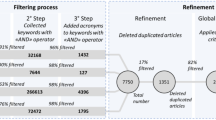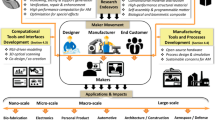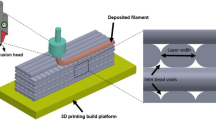Abstract
Three-dimensional (3D) process models are serial intermediate models formed by each process operation during the process of machining a blank into a finished part. They are the process information carriers under the model-based definition (MBD) mode and play an important role in process planning. However, in the traditional design pattern, the 3D process models are mainly constructed manually, which is time-consuming and error prone. In this paper, a novel method for automatically generating 3D process models for shaft parts is proposed. First, an extended feature relation graph (EFRG) is used to describe the topological relationship between the design features (DFs) of the part. Second, the cutting surfaces and the machining method chains are generated based on the design feature surfaces (DFSs). The cutoff surfaces are used to limit the decomposition range of the cutting surfaces to ensure that the machining volume can be decomposed into machining volume units. Then, the machining features are generated by linking the machining method chains to the machining volume units. Finally, the 3D process models are generated by performing Boolean operations. An automatic generation system of 3D process models for shaft parts is developed based on the proposed method, and the effectiveness of the system is verified by typical parts.



















Similar content being viewed by others
References
Quintana V, Rivest L, Pellerin R, Venne F, Kheddouci F (2010) Will model-based definition replace engineering drawings throughout the product lifecycle? a global perspective from aerospace industry. Comput Ind 61(5):497–508. https://doi.org/10.1016/j.compind.2010.01.005
Alemanni M, Destefanis F, Vezzetti E (2011) Model-based definition design in the product lifecycle management scenario. Int J Adv Manuf Technol 52:1–14. https://doi.org/10.1007/s00170-010-2699-y
Ruemler SP, Zimmerman KE, Hartman NW, Hedberg T Jr, Barnard Feeny A (2017) Promoting model-based definition to establish a complete product definition. J Manuf Sci Eng 139(5):051008. https://doi.org/10.1115/MSEC2016-8702
Liu JF, Liu XJ, Cheng YL, Ni ZH (2016) A systematic method for the automatic update and propagation of the machining process models in the process modification. Int J Adv Manuf Technol 82:473–487. https://doi.org/10.1007/s00170-015-7371-0
Houshmand M, Imani DM (2009) A volume decomposition model to determine machining features for prismatic parts. J Appl Sci 9(9):1703–1710. https://doi.org/10.3923/jas.2009.1703.1710
Park S (2006) Generating intermediate models for process planning. Int J Prod Res 44(11):2169–2182. https://doi.org/10.1080/00207540500521527
Zhang SS, Shi YF, Fan HT, Huang R, Cao JJ (2010) Serial 3D model reconstruction for machining evolution of rotational parts by merging semantic and graphic process planning information. Comput Aided Des 42:781–794. https://doi.org/10.1016/j.cad.2010.04.007
Wan N, Mo R, Liu LL, Li J (2014) New methods of creating MBD process model: on the basis of machining knowledge. Comput Ind 65(4):537–549. https://doi.org/10.1016/j.compind.2013.12.005
Gulesin M (1996) Intermediate part modelling in a process planning and fixturing system. Robot Comput Integr Manuf 12(4):321–328. https://doi.org/10.1016/S0736-5845(96)00018-X
Zhang X, Liang C, Si TD, Ding D (2013) Machining feature modeling and process intermediate model generation in process planning. Asme International Design Engineering Technical Conferences & Computers & Information in Engineering Conference. https://doi.org/10.1115/DETC2013-13550
Li JX, Chen ZN, Yan XG (2014) Automatic generation of in-process models based on feature working step and feature cutter volume. Int J Adv Manuf Technol 71:395–409. https://doi.org/10.1007/s00170-013-5507-7
Zhao M, Wang XY (2014) Rapid generation method of mbd process model based on volume decomposition. Comput Integr Manuf Syst 20(8):1843–1850. (in Chinese). https://doi.org/10.13196/j.cims.2014.08.zhaoming.1843.8.2014086
Zubair AF, Abu Mansor MS (2018) Automatic feature recognition of regular features for symmetrical and non-symmetrical cylinder part using volume decomposition method. Eng Comput 34:843–863. https://doi.org/10.1007/s00366-018-0576-8
Kataraki PS, Abu Mansor MS (2017) Auto-recognition and generation of material removal volume for regular form surface and its volumetric features using volume decomposition method. Int J Adv Manuf Technol 90:1479–1506. https://doi.org/10.1007/s00170-016-9394-6
Zhang F, Zhang YF, Nee AYC (1997) Using genetic algorithms in process planning for job shop machining. IEEE Trans Evol Comput 1(4):278–289. https://doi.org/10.1109/4235.687888
Kataraki PS, Abu Mansor MS (2020) Automatic designation of feature faces to recognize interacting and compound volumetric features for prismatic parts. Eng Comput 36:1499–1515. https://doi.org/10.1007/s00366-019-00777-2
Sreeramulu D, Lokanadham D, Rao CSP (2014) Development of computer aided process planning system for rotational components having form features. Proceedings of the Third International Conference on Soft Computing for Problem Solving, Springer India
Huang Z, Yip-Hoi D (2002) High-level feature recognition using feature relationship graphs. Comput Aided Des 34(8):561–582. https://doi.org/10.1016/S0010-4485(01)00128-2
Li WD, Ong SK, Nee AYC (2002) Recognizing manufacturing features from a design-by-feature model. Comput Aided Des 34(11):849–868. https://doi.org/10.1016/S0010-4485(01)00156-7
Gao S, Shah JJ (1998) Automatic recognition of interacting machining features based on minimal condition subgraph. Comput Aided Des 30(9):727–739. https://doi.org/10.1016/S0010-4485(98)00033-5
Babic B, Nesic N, Miljkovic Z (2008) A review of automated feature recognition with rule-based pattern recognition. Comput Ind 59(4):321–337. https://doi.org/10.1016/j.compind.2007.09.001
Sormaz D, Sarkar A (2019) Simpm – upper-level ontology for manufacturing process plan network generation. Robot Comput Integr Manuf 55:183–198. https://doi.org/10.1016/j.rcim.2018.04.002
Kirkwood R, Sherwood JA (2018) Sustained CAD/CAE integration: integrating with successive versions of step or IGES files. Eng Comput 34:1–13. https://doi.org/10.1007/s00366-017-0516-z
Sanfilippo EM, Borgo S (2016) What are features? an ontology-based review of the literature. Computer Aided Design 80:9–18. https://doi.org/10.1016/j.cad.2016.07.001
Availability of data and materials
The authors declare that the data and the materials for the study are available from the corresponding author upon reasonable request.
Funding
This work was supported by the Fundamental Research Funds for the Central Universities (CN).
Author information
Authors and Affiliations
Contributions
He Zhang: investigation, conceptualization, methodology, visualization, writing—original draft.
Xiao-Bo Ge: conceptualization, supervision, and visualization.
Yuan-Ying Qiu: writing—review and editing, validation.
Xiao-Dong Shao: project administration, funding acquisition, resources, validation.
Corresponding author
Ethics declarations
Ethical approval
Not applicable.
Consent to participate
Not applicable.
Consent to publish
Not applicable.
Competing interests
The authors declare no competing interests.
Additional information
Publisher’s note
Springer Nature remains neutral with regard to jurisdictional claims in published maps and institutional affiliations.
Rights and permissions
About this article
Cite this article
Zhang, H., Ge, XB., Qiu, YY. et al. Automatic generation method of 3D process models for shaft parts based on volume decomposition. Int J Adv Manuf Technol 118, 1043–1060 (2022). https://doi.org/10.1007/s00170-021-07968-6
Received:
Accepted:
Published:
Issue Date:
DOI: https://doi.org/10.1007/s00170-021-07968-6




